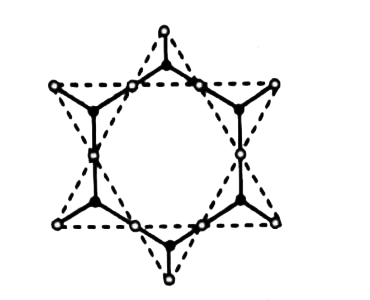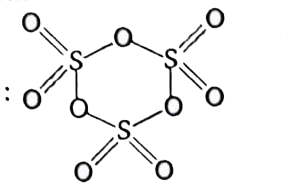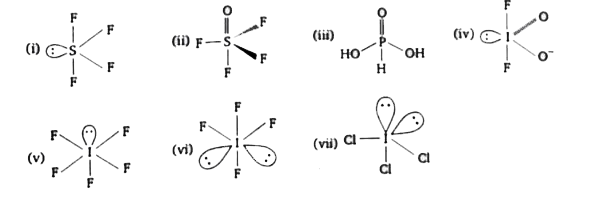Complete Solutions to SUBJECTIVE PROBLEMS of chapter p-BLOCK ELEMENTS of Class 12 book with complete answers and questions
| Class 12 | CHEMISTRY |
| Chapter | p-BLOCK ELEMENTS |
| VK JAISWAL | SUBJECTIVE PROBLEMS |
| Number Of Questions | 36 |
| Academic Year | 2023-24 |
In phosphorus acid, If X is number of non-bonding electron pairs. Y is number of `sigma`-bonds and Z is number of `pi`-bonds. Then calculate value of ``"YxZ-X"`.
View SolutionConsider the following oxyanions:
`PO_(4)^(3-),P_(2)O_(6)^(4-),SO_(4)^(2-),MnO_(4)^(-),CrO_(4)^(2-),S_(2)O_(5)^(2-),S_(2)O_(7)^(2-)`
and find the value of R+Q-P
where P-number of oxy anions having three equivalent X-O bonds per central atom
Q=number of oxy anions having two equivalent X-O bonds per central atom.
R=Number of oxy anions having four equivalent X-O bonds per central atom.
View SolutionFor oxyacid `HClO_(x)`, fi x=y=z (x,y and z are natural numbers), then calculate the value of |x+y+z|. Where x=number of 'O' atoms
y=total number of ions pairs at central atom
z=total number of pi`(pi)` electrons in the oxyacid.
View SolutionConsider the following representation of oxy-acid, `H_(n_(1))S_(2)O_(n_(2))`, (where S is central sulphur atom annd `n_(1) and n_(2)` are natural numbers.) if there are two possible oxy-acid of sulphur A and B contains ratio of `n_(2):n_(1)` are 2 and 4 respectively, then sum of oxidation state of 'S' atom in both oxy-acid will be:
View Solutiontotal number of molecule which hydrolysed at room temperature and hybridization of central atom is `sp^(3)d` in transition state:
`C Cl_(4),SiCl_(4),NCl_(3),PCl_(3),AsCl_(3),SF_(6),P_(4)O_(6),P_(4)O_(10),SeF_(6)`
View SolutionThe difference between total number of lone pairs and total number of `sigma`-bonds in `[B_(3)O_(3)(OH)_(6)]^(3-)` molecular ion is:
View SolutionCalculate vlaue of `|x+y-z|` for the followng sillicate `[Si_(x)O_(y+z)]^(z-)` anion.

View SolutionThe general formula of polythionate ion is `S_(n+2)O_(6)^(2-)`. If average oxidation state of 'S' atom is any polythionate ion is equal to bond order of 'S-O' bond. Then calculate the value of 'n' for the corresponding polythionate ion.
View Solutiontotal number of Boron atoms in anionic part of borax which participate in back bonding.
View SolutionChoose total number of correct reaction.
(i) When `CuSO_(4)` solution reacts with `NH_(3)`, complex is formed.
(ii) When `CuSO_(4)` solution react withh `PH_(3)`, complex is formed.
(iii) `C_(12)H_(22)O_(11) overset("conc. "H_(2)SO_(4)) to 2C+11H_(2)O`
(iv) `underset(("excess"))(NH_(3))+Cl_(2) overset(Delta) to NH_(4)Cl+N_(2)`
View SolutionConsider the following orders:
(1) `H_(2)SO_(4) gt H_(2)SO_(3):`boiling point
(2) `H_(2)O gt HF:` Extent of H-bond
(3) `H_(2)O lt H_(2)O_(2)`: Strength off H-bond.
View SolutionHow many monovalent oxygen atoms are preset in the mineral kinoite `(overset(+2)(Ca_(2))overset(+2)(Cu_(2))Si_(3)O_(10)*2H_(2)O)`?
View SolutionHow many moles off given compound are decomposed in the following decomposition in the following decomposition reaction?
`NaOCl overset(Delta)toNaClO_(3)+NaCl`
View SolutionHow many moles of NaOH are required to react with one mole of solid `N_(2)O_(5)`?
View SolutionHow many moles of hypophophorous acid are involved in its thermal decomposition reaction when one mole of each product is formed.
View SolutionConsider the structure of `Al_(2)Me_(6)` compound and find the value of `(x-y)/(z)` where `x=` maximum number of atoms that can lie in place having terminal `(Al-Me)` bonds
`y=` total number of `3c-2e^(-)` bonds
`z=` total number of atoms that are `sp^(3)` hydrized.
View SolutionSum of oxidation state of nitrogen atom in hyponitrous acid, nitric acid and nitrous acid.
View SolutionFind the value of `x` in the tremolite abestos:
`Ca_(2)Mg_(x)(Si_(4)O_(11))_(2)(OH)_(2)`
View SolutionConsider the following silicates
(a) `BaTi(Si_(2)O_(9))`
(b) `ZnCa_(2)Si_(2)O_(7)`
Then calculate X+Y, where X and Y are total number of monovalent and divalent oxygen atoms in both silicates respectively.
View SolutionAtomicity of white or yellow phosphorus is 4 annd it is represented as `P_(4)` molecule
Calculate the value of expresion`(x*y)/(z)` regarding this molecule.
Where x: total number of vertex angles in `P_(4)` molecule.
y: Total number of lone pairs in `P_(4)` molecule
z: total number of P-P bonds in `P_(4)` molecule.
View SolutionMarshall's acid `overset(H_(2)O) to A+B`
`Aoverset(H_(2)O)toB+C`
If P and Q represent maximum number of atoms that can lie in a plane of compound A and C respectively. Then, find out value of (P-Q).
View SolutionConsider following four compounds:
(i) `C_(x) O_(y)`
(ii) `C_(x)O_(y+1)`
(iii) `C_(x+2)O_(y+1)` and (iv) `C_(x+11)O_(y+8)`,
if "x=y=1", then calculate the vlaue of |p-q|, where p and q are total number of `sp^(2)` and hybridized carbon atoms respectively in given four compounds.
View SolutionIf following molecules undergo dimerisation then find the value of `(YZ)/(X):`
(i) `CiO_(3)`
(ii) `OF`
(iii) `GaH_(3)`
(iv) `AlCl_(3)`
(v) `IC l_(3)`
(vi) `BeH_(2)`
(vi) `NO_(2)`
Where X=Number of molecules which are hypevalennt in dimeric form.
Y=Number of molecules which complete octet in dimer form
Z=Number of molecules which are hypovalent in dimeric form.
View SolutionConsider `Al_(2)(OH)_(6)` compound and caculate the value of `(X+Y)+Z` Wher X=total number of `(2c-2e^(-))` bond.
Y=total number of `(3c-2e^(-))` bond.
Z=total numbe of `(3c-4e^(-))` bond
View SolutionConsider the following covalent compounds in their solid state and find the value of expression `(X+Y+Z)`.
`N_(2)O_(5),Cl_(2)O_(6),PC l_(),I_(2)Cl_(6),XeF_(6),PB r_(5)`
Where X=total number of compounds in which central atom of cationic or anionic part is `sp^(3)` hybridized.
Y=Total number of compounds having `90^(@)` bond angle either in cationic or anionic part.
Z=Total number of compounds having `109^(@)28'` bond angle either in cationic or anionic part.
View SolutionConsider following compounds A to E :
(A) `XeF_(n) " " (B) XeF_((n+1))^(+) " " (C ) XeF_((n+1))^(-) " " (D) XeF_((n+2))`
(E ) `XeF_((n+4))^(2-)`,
If value of n is 4, then calculate value of `p div q` here, 'p' is total number of bond pair and 'q' is total number of lone pair on central atoms of compounds (A) to (E ).
View SolutionWhen `B_(2)H_(6)` is allowed to react with following lewis bases, then how man ygiven lewis bases form adduct through symmetrical cleavage of `B_(2)H_(6)`?
`NH_(3),MeNH_(2),` Pyridine, `CO,T.H.F,PH_(3),PF_(3),Me_(3)N,Me_(2)NH`
View SolutionWhat is covalency of chlorine atom in second excited state ?
View SolutionConsider the following molecule:

Calculate value of q+q, here p and q are total number of `d pi-p pi` bonds and total number of `sp^(3)`-hybridised atoms respectively in given molecule.
View SolutionConsider the following structures and calculate value of `(P^(2)-Q^(2))`
Where P=total number of correct structure representation.
Q=Total number of incorrect structure representation.

View SolutionCalculate the value of " x+y-z" here x,y and z are total number of non-bonded electron pair (s),pie `(pi)` bond(s) and sigma `(sigma)` bonds in hydrogen phosphite ion respectively.
View SolutionConsider the following species:
(i) `CH_(3)^(+)`
(ii) `(C_(3)H_(5))_(3)Al`
(iii) `HCHO`
(iv) `CH_(4)`
(v) `(C_(2)H_(5))_(3)N`
(vI) `TiCl_(4)`
(vii) `CO_(2)`
(viii) `SiCl_(4)`
(ix) `BF_(3)`
the find out total number of species which can act as Lewis acid.
View SolutionConsider the following species: `CF_(4),GeH_(4),BCl_(3),AlBr_(3),H_(2)O,PH_(3),PCl_(5),CO_(2),CH_(4) and ` calculate value of `(x-y)^(2)`:
Where, x: Total number of species which can act as only lewis acid.
y: total number of species which can act as lewis acid as well as lewis base.
View SolutionIf X,Y and Z are total number of `pi`-bond(s) in `H_(2)S_(2)O_(6),H_(2)SO_(3) and H_(2)S_(2)O_(7)` respectively then calculate vlaue of expression `|X+Y-Z|`.
View SolutionCalculate value of "x+y" ffor "hypophoshporic acid", where x is total number of lone pair(s) and y is total number `pi`-bond(s) in givenn oxo-acids.
View SolutionAtomicity of white or yellow phosphorus is 4 annd it is represented as `P_(4)` molecule
Calculate the value of expresion`(x*y)/(z)` regarding this molecule.
Where x: total number of vertex angles in `P_(4)` molecule.
y: Total number of lone pairs in `P_(4)` molecule
z: total number of P-P bonds in `P_(4)` molecule.
View Solution
SUBJECTIVE PROBLEMS questions and complete solutions for chapter p-BLOCK ELEMENTS of VK JAISWAL CHEMISTRY (HINGLISH) of Class 12